From the September 2021 issue of Apollo. Preview and subscribe here.
‘And here, just to show we haven’t quite lost the plot, is the Pre-Raphaelite Room…’ Andrew Lloyd Webber is giving me a tour around his latest passion project, the newly restored Theatre Royal Drury Lane in Covent Garden. Tucked away behind the Grand Saloon on the first floor – where punters can now sip tea from china decorated with figures from the theatre’s safety curtain – is a room dedicated to late works by the Pre-Raphaelites and their followers. Dusty-pink walls glow with pictures that Lloyd Webber previously had either at home or ‘lurking around’, unhung: Burne-Jones’s cartoons for the needlework designs Musica and Poesis; a copy of the artist’s painting Depths of the Sea (‘I’d love to have the original here but I daren’t’); walnut panels, produced by Morris & Co., with the figures of Cleopatra and Lucretia painted against golden flora; John Roddam Spencer Stanhope’s Charon and Psyche; and Sarpedon by William Blake Richmond – ‘a picture that Oscar Wilde went mental about’. But the star here is Burne-Jones’s first major commission, a triptych completed in 1861 for St Paul’s Church in Brighton. The artist’s initial version, now in the Tate collection, was overcrowded and made little allowance for the positioning of a crucifix in front of the altarpiece. ‘So this is the second version,’ Lloyd Webber explains, ‘which Burne-Jones preferred.’
On the far wall of the Pre-Raphaelite Room is Triptych: The Adoration of the Kings and the Annunciation (1860–61) by Edward Coley Burne-Jones. Photo: Tom Mannion
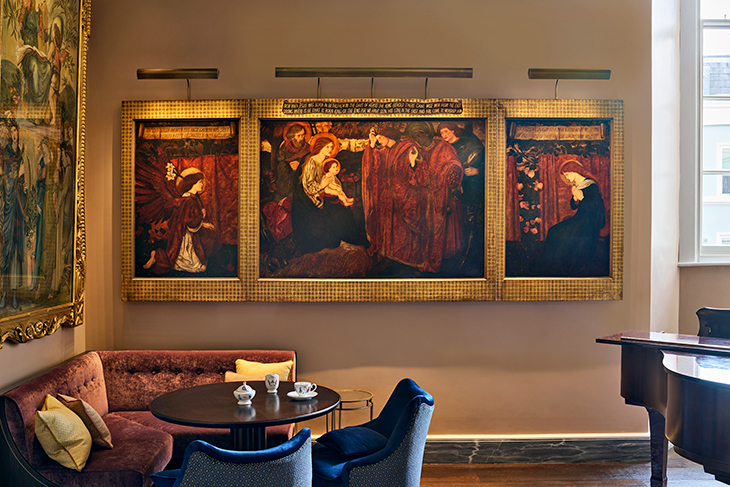
Lloyd Webber mentions losing the ‘plot’ because this Greek Revival theatre is the aesthetic antithesis of the art movement for which he has such a long-held obsession. Following a first-stage restoration eight years ago, he has recently spent £60 million on, among other alterations and improvements, stripping out later accretions to get back to Benjamin Wyatt’s design of 1812. Its clean classical lines are a world away from the melodramatic, pomegranate-populated pictures in the musical impresario’s collection, which encompasses enough works by Millais, Rossetti, Holman Hunt, Burne-Jones and other Victorian artists to warrant a dedicated exhibition – as indeed was staged in 2003 at the Royal Academy of Arts.
A copy of Burne-Jones’s Depths of the Sea – the original of 1886 in Lloyd Webber’s collection – hangs next to a cartoon by Burne-Jones for the needlepoint design Musica. Photo: Tom Mannion
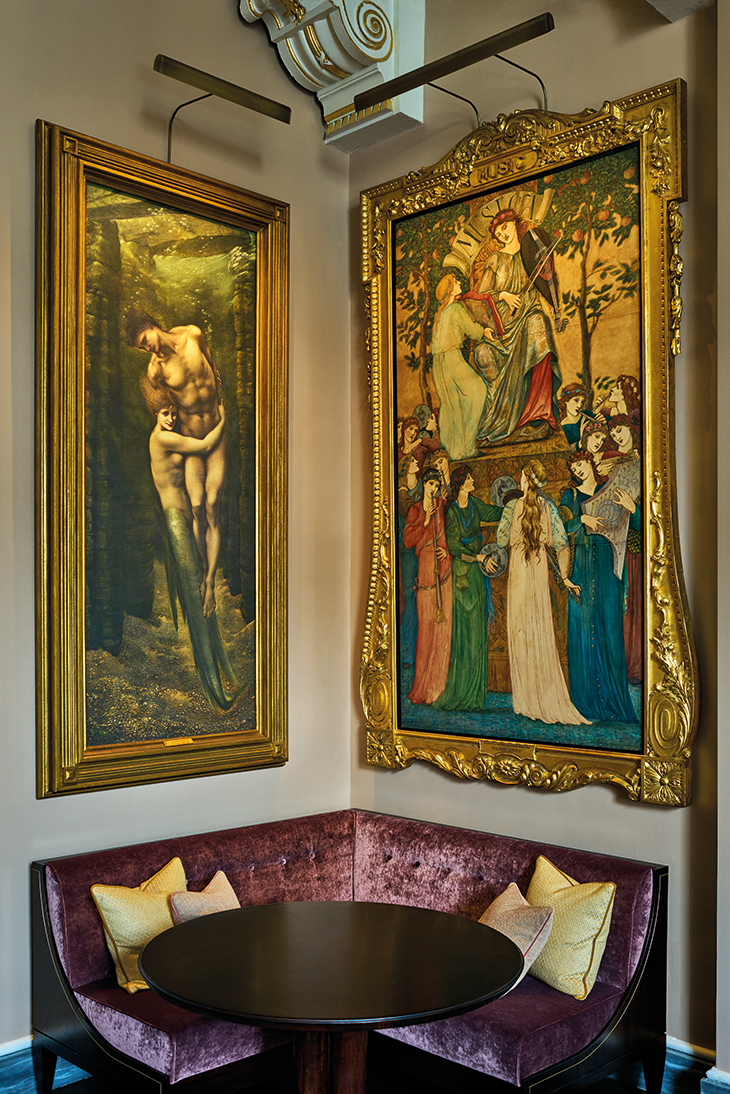
When we meet in early July, Lloyd Webber is in crisis mode. Covid restrictions, about which he has been so vocal this year, are still threatening performances (‘Don’t get me started on that’); a large commission of reproduction furniture for this theatre has had to be made anew after a warehouse fire; and to top it all off, Prince Charming in Lloyd Webber’s much-delayed new musical Cinderella has sustained a hand injury, so they’re having to rehearse the understudy. But, harried though he clearly is, none of this can dampen his enthusiasm when talking about his restoration of the Lane, as this building is known in theatre land. Lloyd Webber collects theatres as well as Pre-Raphaelites: this one, which he bought in 2000, is one of six he currently owns in the West End, and he runs through each of them with a fond précis (the Gillian Lynne is ‘the most flexible theatre in Britain’, and as Cats was first staged there he wanted it ‘for sentimental attachment’; the Cambridge is one he’d ‘like to get at one day’; the Palace, which he sold in 2012, is ‘the theatre that you could call the Pre-Raphaelite one because it was D’Oyly Carte who did it for Sullivan, and it opened with Ivanhoe – it’s a very interesting but problematic building’). ‘This one, obviously, is of enormous architectural importance.’
A Morris & Co. walnut panel from c. 1875 depicting Cleopatra (after Burne-Jones) hangs near a Pugin-style gothic gilt candlestick. Photo: Tom Mannion
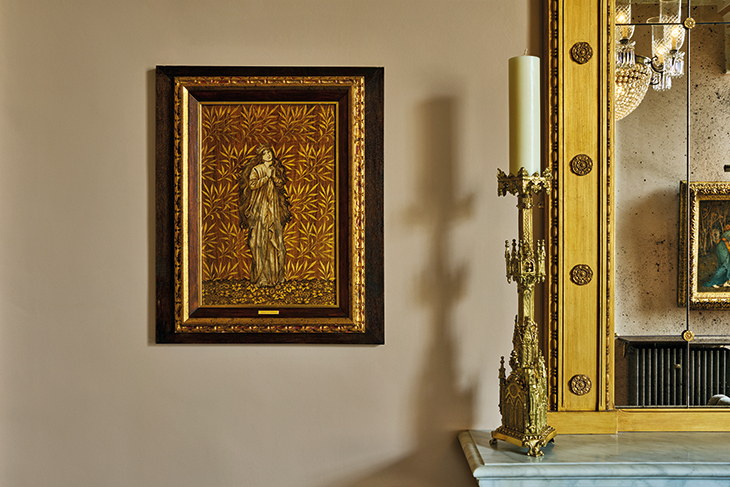
The building we’re standing in is the fourth theatre on this spot, the earliest incarnation dating to 1663 – making it the oldest theatre site in London still in use, old enough for Nell Gwyn to have performed here (not for nothing, then, are there rumours of Phantom-worthy backstage hauntings). That building lasted less than a decade before burning down. Its replacement was managed by, among others, David Garrick, who commissioned the Adam brothers to work on its interior and facade. It was then demolished in 1791 by the politician, playwright and Lane owner Richard Brinsley Sheridan, who had a larger venue built to a design by Henry Holland. That theatre had a chequered 15-year run, with troubled finances and, during one performance, an assassination attempt on George III, before it too met a fiery fate: in one corridor off the auditorium Lloyd Webber has hung a contemporary illustration of the theatre ablaze, a scene which Sheridan is supposed to have watched, drink in hand, observing: ‘A man may take a glass of wine by his own fireside.’ Benjamin Wyatt was commissioned to design the fourth theatre on the site, which was completed in 1812 and opened ‘to an immense audience’, according to the Gentleman’s Magazine, with a production of Hamlet. Wyatt clearly inherited much of his better-known father James’s talent: Dickens pronounced the result ‘the handsomest of theatres’, while more recently Nikolaus Pevsner (a friend of Lloyd Webber) called its front-of-house spaces ‘the best rooms in London’.
Lloyd Webber has worked closely with the architectural historian Simon Thurley to reclaim these rooms and open them up again – ridding the long rectangular foyer, for instance, of added storage rooms and partitions (which had also concealed but not destroyed much of the original floor). ‘So now you’ve got the whole perspective looking from one end to the other.’ This grand space, he says, ‘was where originally everybody’s staff would wait. You left all your coats and your bits and pieces here with your driver.’ The average theatre-goer nowadays may not enjoy that luxury, but the circular room that leads off the foyer, with its coffered domed ceiling and gallery, provides the ideal setting for impersonating Regency bucks and Georgette Heyer heroines. ‘The whole idea with Wyatt,’ Lloyd Webber explains, ‘was you drew people in through the rotunda. So we created a bar here to bring people in.’ New iron torchères, based on historical designs, add further warmth to calamine-pink walls. ‘This colour scheme was something that Simon and I pondered and pondered, because it was clear from the layers of paint here that originally they never felt they had it right, it was always very cold. We went back and back through about 14 different coats.’ (I resist making a joke about coats of many colours.) The shade eventually alighted upon they took from Woodhall Park in Hertfordshire – though it’s not far off the colour of the dado in George Cruikshank’s illustration The Green Room at Drury Lane Theatre (1821).
Benjamin Wyatt’s rotunda, with John Cheere’s 18th-century statue of Shakespeare supervising the bar. Photo: Tom Mannion
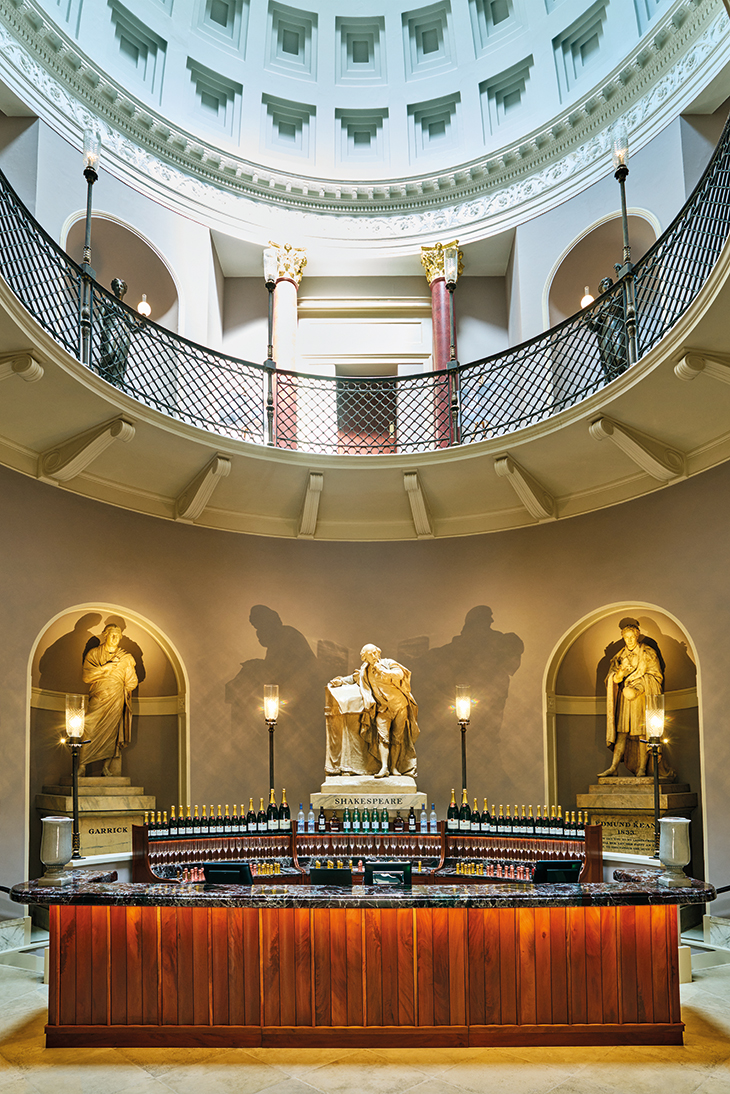
In pride of place behind the rotunda bar, flanked by statues of Garrick and the actor Edmund Kean, is a painted-lead statue of Shakespeare (based on the monument by Peter Scheemakers in Westminster Abbey) by the sculptor John Cheere, which had been presented to the Lane in 1809 by the brewer-MP Samuel Whitbread. It has been ‘retrieved’ from a less conspicuous place and given a new plinth, Lloyd Webber explains, ‘to prove John Gielgud wrong’. Lloyd Webber recalls being taken to the Lane as a boy in the late 1950s to see Gielgud as Prospero in The Tempest. ‘He very memorably on the last night broke Prospero’s staff, and said Shakespeare would never be heard again in this theatre – that it was lost to American musicals. The show coming in then was My Fair Lady, which was the next show I saw, actually.’ The statue stands as a promise of sorts. While musicals are still the order of the day here – work is in progress in the auditorium in preparation for the stage version of Disney’s Frozen – Lloyd Webber says he intends to have Shakespeare performed here at some point. However, ‘Right now we just need to make some money.’ (The auditorium itself, which dates to 1922, has been significantly modified so that it now has perfect sight lines, and the stage can play in the round, as well as being able to take as much as an 81-piece orchestra.)
The Shakespearean theme continues at the bottom of Wyatt’s twin cantilevered staircases either side of the rotunda (the King’s Side and the Prince’s Side, ‘because as you know George III and his son fell out, so they had to have their own separate entrances’). Having seen an article on the Brooklyn-based artist Maria Kreyn in Vanity Fair – which described her as ‘resembling a Pre-Raphaelite muse herself’ – Lloyd Webber commissioned Kreyn to paint eight canvases for this space based on Shakespeare’s work. ‘Not a scene from the plays,’ he explains, ‘but the essence of the plays.’ With this restoration in mind, Lloyd Webber was interested in the fact that Kreyn did things at scale; then, when he visited her studio, he saw a painting of hers that reminded him of Ophelia. ‘And that’s when we said, let’s do Shakespeare, because it seemed so obvious. Because this was the home of Shakespeare for years and years.’ As with the works in the Pre-Raphaelite room and elsewhere, Kreyn’s paintings have been intelligently lit with unobtrusive LEDs by art-world specialists TM Lighting, granting them a prominence that manages not to detract from their architectural setting.
One of Benjamin Wyatt’s two cantilevered staircases at the theatre, with a painting by Maria Kreyn from 2021 at its foot. Photo: Tom Mannion
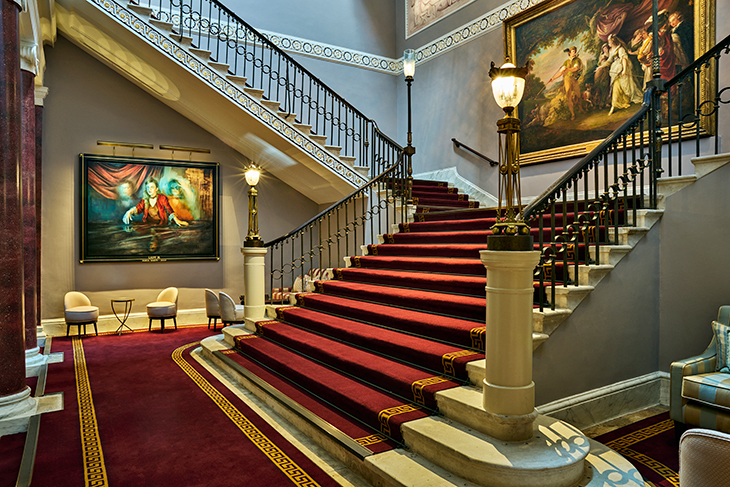
As a collector of Victorian art, Lloyd Webber already lives with a strong cast of Shakespearean characters. The Royal Academy exhibition in 2003 revealed four Ophelias: a later, watercolour version of Millais’s famous painting in Tate Britain; one by Arthur Hughes; and two by Waterhouse, from 1889 and 1910. Other holdings included a drawing of Desdemona by Rossetti; Frederick Sandys’s Perdita, and Richard Dadd’s Contradiction: Oberon and Titania. As it happens, though, it’s The Tempest that has become ‘a rather sore subject’ for Lloyd Webber. In 2019, a temporary export bar was placed on Millais’s Ferdinand Lured By Ariel (1850), which has been in the Makins family since 1897. ‘I can’t understand it,’ he says: ‘I offered the price put on it [£9.5m], and was going to do it in association with the Ashmolean, but the owner turned the offer down. Now we’ve heard it’s been given a three-year temporary export licence to go to the Met, which is absolutely disgraceful because it’s the seminal image of the Pre-Raphaelite movement; so I don’t know how this back-door thing has happened.’
Although in this case Lloyd Webber is more concerned about keeping the painting in the UK than having it for his own walls, it’s not the first time his attempts to buy a Victorian masterpiece have been thwarted. In an often-repeated story, Lloyd Webber was still a schoolboy in South Kensington when he took a shine to a grimy, unframed canvas in a shop on the Fulham Road. His grandmother – echoing the sentiments of many modernists and much of the art establishment of the time (and since) – refused to lend him the £50 the dealer was asking for it, insisting: ‘I will not have Victorian junk in my flat.’ And that was how he missed out on Leighton’s magnum opus, Flaming June, which soon after found its way to the Museo de Arte de Ponce in Puerto Rico. (Lloyd Webber resists my efforts to find connections between the music and the art in his life, but he himself has acknowledged the parallels between his unfashionable love for Victorian art and for the musicals of Rodgers & Hammerstein. Happy as ever in the role of taste rebel, as we ascend the theatre’s staircase he points out a series of grisailles he commissioned of scenes from Oklahoma, Show Boat, South Pacific, et al. He himself appears in one imagined scene with Richard Rodgers: ‘I did meet him when I was a very young man. Rodgers is my hero really.’)
The newly restored entrance foyer of the Theatre Royal Drury Lane. Photo: Tom Mannion
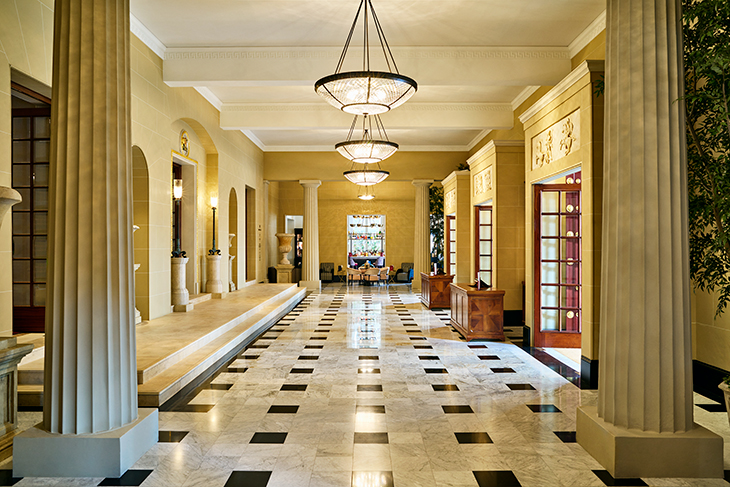
Lloyd Webber has made up for the loss of Flaming June in the intervening years. From early acquisitions such as drawings by Burne-Jones and Rossetti, and an almost Surrealist window design by Millais from 1853, he would go on, after the financial successes of musicals such as Evita, Cats and Phantom of the Opera, to buy many of Victorian art’s greatest hits (and to have that fantastical Millais window design realised at his house in Hampshire). He owns some 40 works by Burne-Jones alone, while his penchant for the movement’s ‘doomed woman’ figure is perhaps best represented by Rossetti’s Proserpine (a favourite) and A Vision of Fiammetta. There are outliers, too. In the room next door to the Pre-Raphaelites at the Lane is a copy of Canaletto’s view of the Old Horse Guards, the original of which is owned by Lloyd Webber’s foundation and on long-term loan to the Tate. Picasso’s painting of Angel Fernández de Soto, meanwhile, was bought partly for what he sees as a debt to Burne-Jones in the Spanish artist’s Blue Period (he has pointed to The Fall of Lucifer, also in his collection, as showing proto-cubist qualities).
And what of future acquisitions? There is, as he points out, very little of Victorian art worth having that is not already in museums. ‘I don’t know what’s going to happen to Holman Hunt’s Death of Rienzi, which Harry Hyams had. That’s sort of a museum picture really – there are some that are a little bit much to have at home; Rienzi I think might be a bit overpowering… Isabel Goldsmith’s got Hope [by Burne-Jones], but she’s never going to part with that.’ He wants his collection to be accessible to the public in the future. ‘How that’s going to be done, I don’t really know,’ he says. ‘I don’t want it to be broken up, as it is actually quite carefully thought through now.’
Lloyd Webber’s great love for these artists was first stirred by 19th-century church architecture – and particularly that of William Butterfield’s All Saints Margaret Street in London, where his father played the organ. But given that he’s been waxing lyrical about the ‘purity’ of the Lane’s architecture, has he been converted to the classical? It seems not: ‘Did you know Pugin worked on opera sets at Covent Garden? When he was a very young man he was a back-stage scene shifter. I was really hoping that we could find evidence that he worked here…’ Matters of architectural taste, however, will have to be put on hold at the theatre at present. Right now, Lloyd Webber says, ‘I just can’t wait to get it full of people.’ And with that, he’s off to rescue Cinderella.
From the September 2021 issue of Apollo. Preview and subscribe here.



